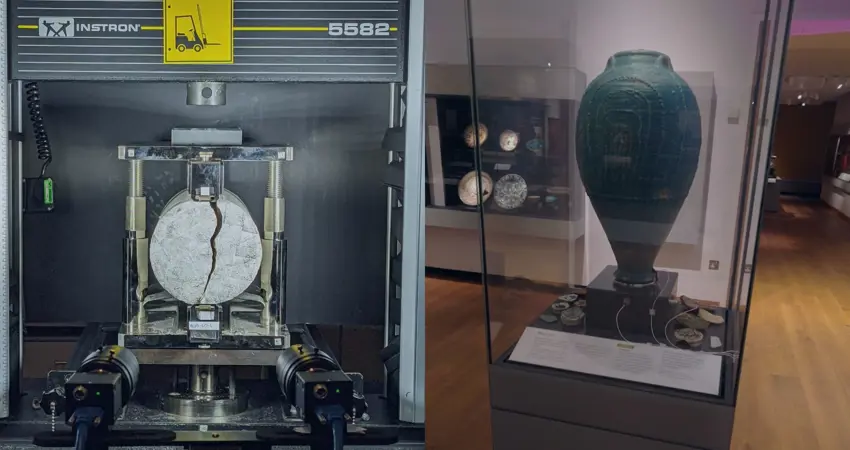25 Oct 2024
Engineers part of multi-disciplinary Oxford team leading Heritage science Research and Engagement project
Major research and innovation investment will harness the latest technology to safeguard heritage for future generations, including new and updated equipment in eight participating laboratories

L: Engineers will use lime mortar disc splitting equipment similar to that shown. Lime mortar is commonly used in historic buildings. R: Accelerometers being used in the Ashmolean.
The University of Oxford is to play a leading role in a major £80m research and innovation investment to harness the latest technology to safeguard heritage for future generations. The funding, from the UKRI Arts & Humanities Research Council, will support a new nationwide Research Infrastructure for Conservation and Heritage Science (RICHeS) programme.
As part of RICHeS, a multi-disciplinary team of Oxford University researchers has been awarded close to £1 million to lead the Oxford Collaboration in Heritage science Research and Engagement (OCHRE) project. Its goal is to support, enhance, and connect Oxford’s world-class strengths in built heritage, collections, and archaeology through a sustainable heritage science hub, linked to a network of new and updated equipment in eight participating laboratories.
“Using the latest technology and scientific equipment, this programme will support access to heritage collections, grow the UK’s heritage economy and drive technological innovation in areas such as material science.”
Professor Christopher Smith, AHRC Executive Chair
Professors Manolis Chatzis and Sinan Acikgoz of the Department of Engineering Science will help train users and advise on the use of two new pieces of equipment for monitoring heritage structures, museum exhibits and gallery contents:
- An autonomous system of accelerometers and microphones for monitoring vibrations and noise within heritage structures and around exhibits of interest (PI Manolis Chatzis).
- A new Digital Image Correlation (DIC) camera system to monitor displacements and deformations of heritage structures and exhibits of interest (PI Sinan Acikgoz).
Professor Manolis Chatzis says, “With this new equipment we are contributing to a network of sensors that allow a complete monitoring of heritage structures and items, spanning from chemical testing to structural testing”.
Professor Heather Viles (School of Geography and the Environment), who will lead the OCHRE team, says, “This amazing AHRC RICHeS grant will make a step-change in our capacity to carry out cutting-edge research which will directly support the conservation and understanding of built heritage, archaeology, and collections.”
OCHRE will be a highly interdisciplinary project, bringing together researchers from the Departments of Engineering Science, Geography, Archaeology, Materials, and Chemistry, besides the Bodleian Library and Ashmolean Museum. The investment will enable a step-change improvement in the University’s ability to carry out imaging, chemical, and structural analysis, and portable analysis for heritage projects.
David De Roure, Professor of e-Research at the Oxford e-Research Centre and Academic Director of Digital Scholarship in the Humanities Division, is on the advisory board of the new project.
Professor Viles adds: “Together, the infrastructure funded through the OCHRE project will be uniquely able to evaluate mechanical, physical, and chemical characteristics of a wide range of heritage materials and therefore provide scientific research support to a broad array of heritage partners – from small museum collections to large, high-profile heritage sites.”




